The Japanese maple is a real feast for the eyes and no doubt the muse of many artists. They are delicate and colourful, but can also provide shade whilst being ornamental.
In our guide, we look at the features and varieties of the Acer palmatum, how to grow and care for this shrub/tree, what pests and diseases to be aware of, and share info about propagation.
More...
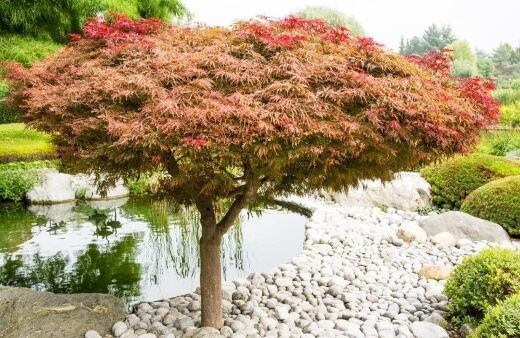
Genus: | Acer |
|---|---|
Species: | A. palmatum |
Family: | Sapindaceae |
Common name: | Palmate Maple, Smooth Japanese maple |
Plant type: | Deciduous tree |
Sunlight: | Full sun |
Watering: | Moderate |
Soil: | Well-drained, slightly acidic |
Flowers: | Small, reddish purple |
Fruits: | Yes |
Height: | 4 to 8 metres |
Spread: | 4 to 8 metres |
Maintenance level: | Low |
Poisonous to pets: | No |
Introducing Japanese Maple
Acer palmatum is native to Japan, North and South Korea, China, eastern Mongolia, and southeast Russia. Japanese horticulturalists have been developing Japanese maple cultivars for centuries, attracted by the leaf shapes and colours.
In nature, Acer palmatum shows so much genetic variety. Seedlings from the same parent tree can have many differences in leaf size, shape, and colour.
The Swedish doctor-botanist Carl Peter Thunberg travelled through Japan in the late eighteenth century. He brought home drawings of Acer palmatum and named it after the hand-like shape of its leaves. This is similar to the old Japanese names kaede and momiji which refer to the 'hands' of frogs and babies.
The first specimen of the tree arrived in England in 1820 and since then, it’s been cultivated in temperate regions all over the world. When you think about this plant, an oriental garden comes to mind.
Acer palmatum is often used as an accent tree in Japan – it offers gentle shade in summer and gorgeous colours in autumn. This plant grows slowly and does well in pots, smaller gardens, and is ideal for courtyards and patios.
These trees make good borders and ornamental paths because the root systems are compact and non-invasive. You can plant Japanese maple near water, in a woodland setting and in rock gardens.
Features of Japanese maple
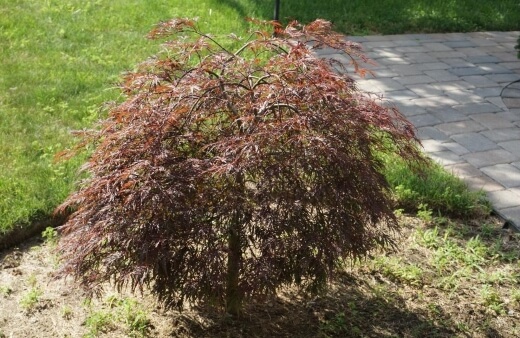
Japanese maples have the most incredible autumn colours, with shades of purples, reds, yellows, oranges, and greens during the growing season.
The fruits of Acer palmatum are called samaras. They have a long shape and the fruit covering is dry and hard, with a colour ranging from green to reddish green.
Acer palmatum has hundreds of cultivars – they showcase a huge variety of shapes, colours, leaf types, sizes, and ideal growing conditions. The height of mature trees can be anywhere from 50cm to 25m, depending on the type.
Some cultivars are strong trees and others are small shrubs. There are even delicate cultivars that barely reach a height of 30cm and are usually grown in pots.
Cultivar colours range from chartreuse to dark green, from red to dark purple, and others are variegated with patterns of white and pink.
The various cultivars have seasonal characteristics that set them apart. These include the colour of new or mature leaves, bark that becomes brighter during winter, and the shape and colour of samaras.


Get Your Free Guide:
Master Growing Australian Natives eBook
A Must Have Complete Guide for Every Australian Garden
Get Your Free Guide:
Master Growing Australian Natives eBook
A Must Have Complete Guide for Every Australian Garden
The samara fruit has one seed surrounded by wing-like tissue which carries it away when the wind blows. Acer palmatum have double-winged samaras which appear after the flowers in autumn.
Japanese Maple Varieties

The varieties of Japanese maple range from dwarfs to midsize to large and the shapes are anything from vase shaped, to cascading. Leaves can be star shaped or mostly round and others are almost like lace.
Acer palmatum has so much genetic variation in nature and the tree can be anything from upright to weeping. This plant are usually described as one of the following:
- Vase: The branches grow up and out, so they are narrow at the base but wide at the top.
- Weeping: The branches arch downwards and cascade like a waterfall.
- Compact/dwarf: These grow to a small height of between 7 and 15 cm, perfect for growing in a pot.
There are three subspecies of Acer palmatum:
- Acer palmatum subsp. palmatum has small leaves and is found at lower altitudes throughout central and southern Japan.
- Acer palmatum subsp. amoenum has larger leaves and is found at higher altitudes throughout Japan and South Korea.
- Acer palmatum subsp. matsumurae also has large leaves and occurs at higher altitudes throughout Japan.
Check out our comprehensive guide maple trees and find out more about it's many varieties.
How to Grow Japanese Maple
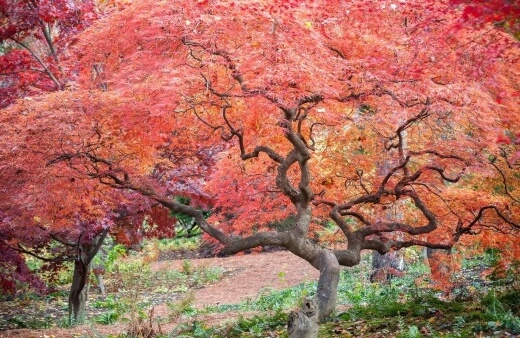
Autumn is the perfect time to plant Japanese maple because it allows the roots to establish while the rest of the tree is dormant. Some gardeners also find success planting in spring, as long as there is no frost threat.
Many of the smaller Japanese maple varieties grow well in containers as they self-stunt. This means that their top growth decreases when the roots are confined.
Keep the compost moist, but not soaking wet, and feed in spring and early summer with a slow-release fertiliser or liquid feed. You will need to re-pot into a slightly bigger pot every couple of years.
The roots of this plant in pots are sensitive to very severe frost in winter. You can wrap pots with a sheet of bubble wrap.
Sunlight Requirements
Acer palmatum loves cool and moist conditions. If growing in this kind of climate, they can be planted in full sun. They also do well planted in semi-shade or where they can get morning or late afternoon sun.
The red and purple leaved cultivars need some sun to fully develop their dark colours but the variegated Japanese maples need protection from the hot midday and afternoon sun, otherwise their leaves will burn.
Best Soil for Japanese Maples
This plant prefer a slightly acidic, sandy, well-drained soil with lots of organic matter, but they can adapt to most garden soils, as long as the soil isn’t very alkaline. Japanese maples can adapt to clay, loam, loamy sand, peat, sandy clay, and sandy loam soils.
If you live in an area with heavy clay soil, you can plant your Japanese maple slightly elevated as this helps guard against root rot and disease. Yellowing of the leaves from lack of chlorophyll can happen in high-pH soils.
If you need some advice regarding soil care, have a look at our soil care articles that cover everything from the best types of mulch to the best compost bins.
Climate Exposure
Japanese maples need to be planted in a wind-sheltered area and be sure to water them well during dry spells in summer. Acer palmatum has shallow fibrous root systems that don’t like competition from other plants, so just make sure they’re not too crowded.
Caring for Japanese Maple
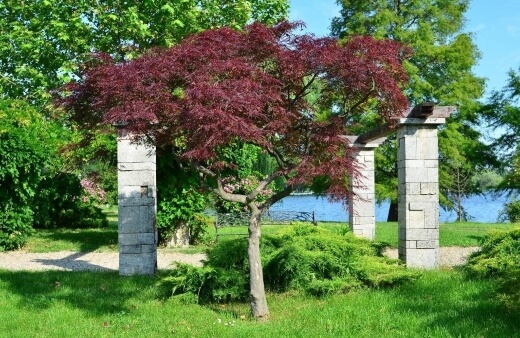
Mulching and Fertilising
Japanese maples need mulch to protect their roots from heat and cold. It also reduces the frequency of watering. Make sure the mulch doesn’t come into contact with the trunk of the tree.
You can mulch every few years with compost or well-matured manure. The Japanese maple will grow strong if you don’t over fertilise. Low-nitrogen fertiliser is fine in spring, N-15 or lower is ideal, but it’s best to wait until their second growing season.
See our complete Australian garden fertiliser users guide.
Watering Acer palmatum
Water well when planting it and regularly thereafter. They can handle periodic dry spells once they’re established, but water your tree regularly during extreme drought.
Pruning Japanese Maple
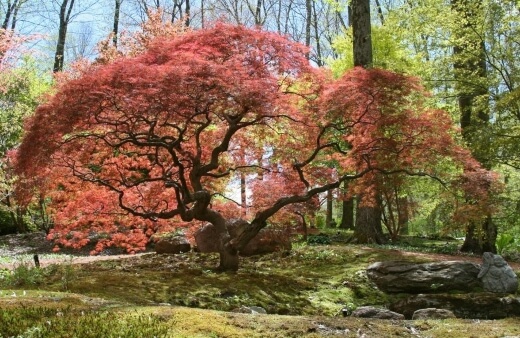
This plant don’t need regular pruning and end up creating their own naturally beautiful shape if you just leave it to develop. If you want to create a canopy, you can remove the lower limbs and if you’re reducing height and width, you can follow the longer branches back to a side branch and cut it at that point.
This plant don’t fit into the common pruning seasons because sap will ooze from the cuts and can cause disease and make your tree weak. They need to be pruned when the plant is completely dormant.
Do your structural pruning in the winter, and in late spring after the leaves come out, you can then do any fine pruning.
Propagation of Japanese Maple
Propagating Japanese Maple from Seed
The trick with Japanese maple seeds is that they will have cross-pollinated so the resulting tree grown from that seed might look a little different than expected. It’s still worth propagating – you might just end up with an exciting new Acer palmatum variety.
If you are sowing fresh seed, you need to soak them for twenty-four hours, and then refrigerate them for ninety days, mixing them with a small amount of compost in a plastic bag that has ventilation.
After the ninety day period, the seeds can be sown in pots or outdoors in a warm spot. Any seeds collected and stored from the year before can be sown in spring directly in the ground or containers.
You want to collect ripe seed in autumn, when the seeds are brown and beginning to fall off the tree. Store them in a paper bag in a cool and dry location.
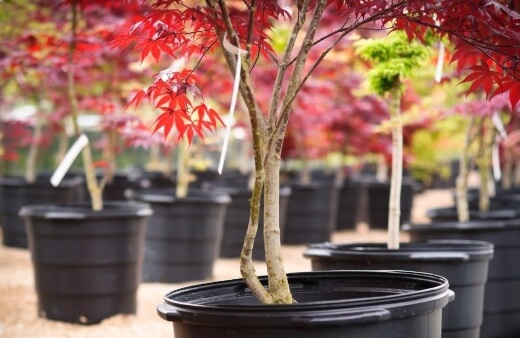
How to Propagate Japanese Maple from Cutting
The best time of year to take cuttings from Japanese maple is mid spring, about a month after the tree has started growing again. Take a softwood cutting – this is new wood that is slightly hardened as they root better than old wood cuttings.
Mix equal parts of sand and peat moss to create a rooting mixture and fill individual pots (about 10 cm) for the number of cuttings you want to plant. Take cuttings that are 15 to 20cm in length and aim to use small but healthy branches for the cuttings.
Remove leaves from the bottom third of the cutting and scrape away the bark along the bottom 4cm to create a wound. Maple cuttings actually root better when wounded.
Dip the end of the cutting in a rooting hormone powder, then place one cutting in each pot, burying 2.5cm of the cutting in the mixture you created.
Water planted Japanese maple cuttings until the rooting mix is moist and you can then move cuttings outside to a partial sunny spot, covering the pots with a plastic bag to create humidity.
Be sure to check the moisture level of the rooting mix and water it daily. The cuttings should root in about 2 to 3 weeks.
(In the past, we suggested the use of peat/sphagnum moss. But, in light of its environmental impact, we've adjusted our recommendations to favor more eco-friendly alternatives that are equally or even more effective. Be sure to read our guide If you're interested in exploring peat moss and its substitutes.)
Japanese Maple Propagation from Grafting
Most of the Japanese maples that are sold commercially have been grafted. Grafting is a very old method of reproducing plants, especially those that are difficult to grow from seed and cuttings.
Japanese maples are one of those trees. Grafting involves growing together two closely related species. The roots and trunk (rootstock) of one type of this plant are placed together with the branches and foliage (scion) of another to form one tree. The two are carefully joined and allowed to grow together.
Japanese Maple Pests and Diseases

This plant don’t really have any serious insect or disease problems. Things to look out for that might affect Acer palmatum are:
- leaf spots – these brown spots on the leaves don’t cause much damage. You can remove the infected leaves, keep foliage dry and use fungicide if necessary.
- Fusarium – infected plants tend to be stunted, the leaves turn yellow and start to wilt and drop off. Remove infected tissues and treat with a soil fungicide.
- Verticillium wilt – causes dieback in the plant and the leaves will wilt. There is no effective treatment other than pruning affected areas of the plant.
- Root rot – you’ll notice wilted, yellow or brown leaves, branches dying back and poor growth. Trim away rotting roots, prune foliage and replace the soil in the case of a potted plant.
- Mites – you can wash foliage with a soft cloth or treat with insecticidal soap.
- Aphids – one of the most common garden pests but not too harmful. Common symptoms include yellow leaves and abnormal growth. You can spray infested plants with a strong stream of water and treat with neem oil, insecticidal soaps, and horticultural oils.
- Scale – you’ll notice raised bumps on the leaves and stems. Prune infected branches and use rubbing alcohol for light infestations. You can also spray with horticultural oil.
Japanese Maple Frequently Asked Questions
Can you eat Japanese maple leaves?
Japanese maple leaves can be a delicious treat. Imagine a sugary batter and frying them up. Fried maple leaves are a popular snack in Osaka and have been for about a thousand years.
The maple leaves are dipped and fried in tempura batter, giving them a unique taste. Some chefs store their leaves in barrels of salt for a year, to make them extra tasty.
What could you compare the seeds of a Japanese maple to?
The samara are more commonly known as helicopter seeds. They are not like apples or oranges but are more similar to acorns.
Can a Japanese maple tree really get sunburnt?
Japanese maple leaves are delicate and can burn if watered when the day is too hot. The tiny drops of water magnify sunlight on the leaves and cause a burn.
The tree can also get very thirsty and take up too much water into the leaves, causing edge burn.
Can you grow a bonsai from a Japanese maple?
Yes, it is possible and growing a bonsai from this plant might even be easier than other trees. Once they are planted in a pot, it’s unlikely that they’ll outgrow that pot.
If you are a bonsai tree enthusiast, have a look at our bonsai tree growing guide which includes some starter kit reviews.
Do Japanese maples attract lots of wildlife?
These plant are monoecious – this means they have both male and female flowers on the same plant. The flowers are small and don’t attract insects, but many songbirds find them a personal favourite.
The seeds of the Japanese maple are a popular menu choice for squirrels, chipmunks and other small mammals.
Looking for more trees to grow in your garden? Check out our how to grow and care guide for Jacaranda trees to add that ornamental tropical look to your backyard.

Wrapping Up Our Japanese Maple Guide
The image of this plant is certainly a popular one. It’s one that we’ve seen on many a screensaver, shared travel photo, or inspirational quote, and all because they really are a sight to behold. The colourful leaves of these trees are just such a visual delight.
Acer palmatum is low maintenance and equally comfortable in a garden bed as it is in a pot, making it versatile and adaptable to your garden requirements.
You might not go as far as enjoying deep fried maple leaves as per the Japanese tradition, but you’ll be able to enjoy your Japanese maple and its gorgeous display of colour for many years to come. We’re giving it our green thumbs up.
Published on May 12, 2022 by Maisie Blevins
Last Updated on February 26, 2025




